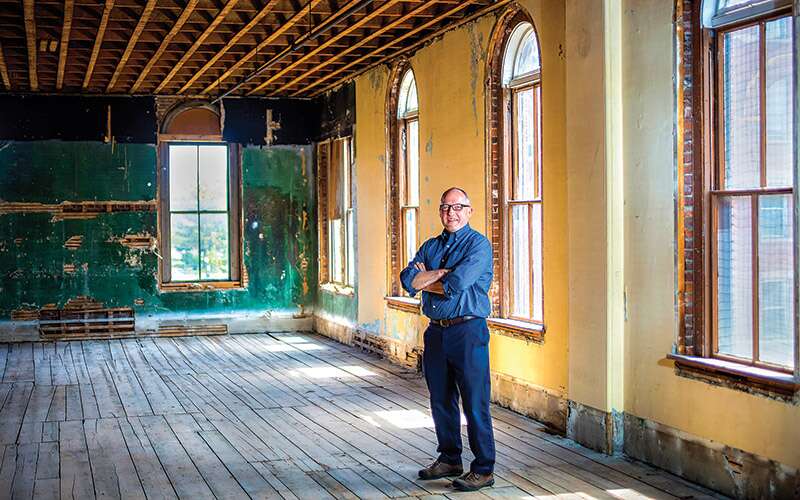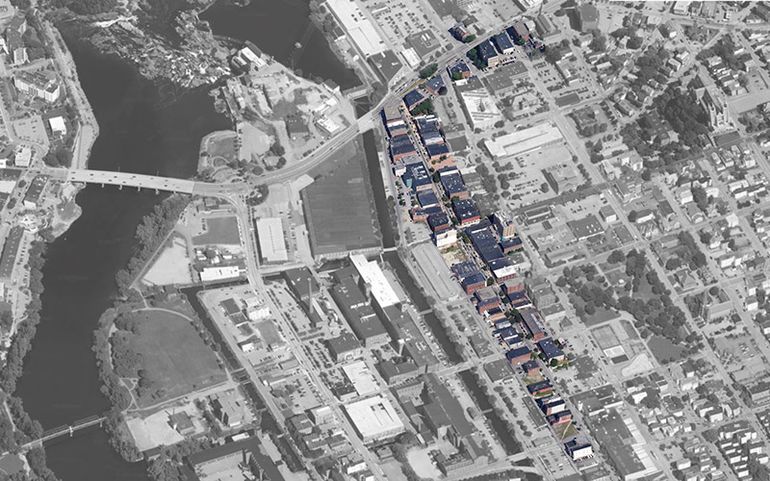
Downtown Lewiston is booming and tax credit programs are helping
 Courtesy / Downtown Lewiston
Lewiston's new historic district covers much of the downtown.
Courtesy / Downtown Lewiston
Lewiston's new historic district covers much of the downtown.
The formation of a new Commercial Historic District in Lewiston is expected to be a boon to the city, allowing property owners along downtown Lisbon and Main streets to take advantage of federal and state tax credit programs for building renovations.
Misty Parker, an economic development specialist, told Mainebiz that many of the buildings in the district — which comprises over 80 properties, many dating back to the 19th century — are listed on the register individually.
But the city’s interest in achieving district designation was driven in recent years by increasing interest in property redevelopment, combined with a limited financial pool to help make some of the more complicated project happen.
“It was apparent that historic tax credits were an important part of that funding mix,” Parker said. “So the city decided to move forward with doing an actual district that encompasses all of the building,” including those that were not individually listed or included in another district.
An example of a building that will benefit from the designation, she said, is the Scruton Block, at 197-199 Lisbon St. Built in 1873, it was home to Bradford Conant & Co. furniture store until the Great Depression. A number of furniture stores followed. The last commercial use was Compass Coin, which offered resales of antiques and coins, Parker said.
“That was one of the projects that helped push the city to move forward with the designation, because individually that building had been altered so many times on the interior that it didn’t qualify to be individually listed,” she said. “But the exterior of the building was well preserved, even under the old 1960s aluminum panel skin.”
District now in National Register of Historic Places

That building is owned by Jules Patry, owner of DaVinci's Eatery in the nearby Bates Mill. Earlier this year, Patry told Mainebiz he acquired the building to do renovations for mixed use. Removing the exterior sheathing revealed an 1883 façade with massive steel columns.
“We were really excited when Jules purchased the building,” Parker continued. Now, through the district, the building is listed as a contributing building and therefore will be eligible for historic tax credits. Patry’s project proposes to fit out the street level for commercial use and the upper floors for 12 apartments, she said.
The city’s overall goal is to maintain the district’s history and features but also help owners meet a huge demand for residential apartments in the downtown, she said.
Most of the structures are along five blocks on Lisbon Street and three blocks on Main Street. A couple go up along Park Street.
The city announced the Lewiston Commercial Historic District was entered in the National Register of Historic Places by the National Park Service on Oct. 4.
The new district comprises a significant portion of downtown Lewiston along Lisbon and Main streets.
“The creation of the historic district incentivizes investment and economic growth in downtown by allowing rehabilitation of most historic buildings to take advantage of the Federal Historic Preservation Tax Incentives program,” according to a news release. “This program encourages private sector investment in the rehabilitation and re-use of historic buildings. It creates jobs and is one of the nation’s most successful and cost-effective community revitalization programs.”
Some of the contributing buildings are now eligible for historic tax credit programs, which will help owners with their revitalization projects. That will be especially useful as some owners are looking to open up upper floors of their buildings, that haven’t been used for a long time or were underutilized, said Parker.
According to the Maine Historic Preservation Commission, income tax incentives for the rehabilitation of historic structures are important tools for historic preservation and economic development. A federal income tax credit for the rehabilitation of historic structures first appeared in 1976 and today consists of a 20% credit for the certified rehabilitation of certified historic structures. The commission administers that program.
In addition, Maine's State Historic Rehabilitation Tax Credit Program includes a 25% state credit for any rehabilitation that also qualifies for the 20% federal credit; a 25% state credit for the rehabilitation of certified historic structures with certified qualified rehabilitation expenditures of between $50,000 and $250,000; and an "Affordable Housing Rehabilitation Credit Increase” that increases the previous two to 30% if the rehabilitation project results in the creation of a certain amount of affordable housing. There is a "per project" state credit cap of $5 million.
The majority of the buildings in the district qualify as contributing structures to the district; some of the properties don’t qualify, said Parker.










Comments